PORSCHE 911 GT2 2010 5.G Information Manual
Manufacturer: PORSCHE, Model Year: 2010, Model line: 911 GT2, Model: PORSCHE 911 GT2 2010 5.GPages: 35, PDF Size: 3.73 MB
Page 11 of 35
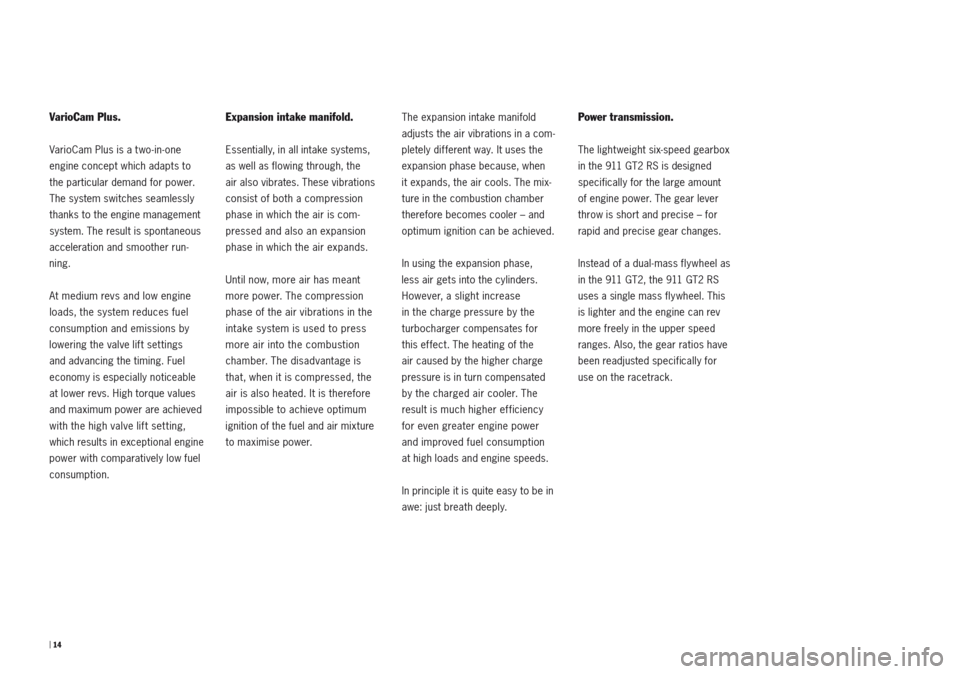
| 14
VarioCam Plus.
VarioCam Plus is a two-in-one
engine concept which adapts to
the particular demand for power.
The system switches seamlessly
thanks to the engine management
system. The result is spontaneous
acceleration and smoother run-
ning.
At medium revs and low engine
loads, the system reduces fuel
consumption and emissions by
lowering the valve lift settings
and advancing the timing. Fuel
economy is especially noticeable
at lower revs. High torque values
and maximum power are achieved
with the high valve lift setting,
which results in exceptional engine
power with comparatively low fuel
consumption.
Expansion intake manifold.
Essentially, in all intake systems,
as well as flowing through, the
air also vibrates. These vibrations
consist of both a compression
phase in which the air is com-
pressed and also an expansion
phase in which the air expands.
Until now, more air has meant
more power. The compression
phase of the air vibrations in the
intake system is used to press
more air into the combustion
chamber. The disadvantage is
that, when it is compressed, the
air is also heated. It is therefore
impossible to achieve optimum
ignition of the fuel and air mixture
to maximise power.The expansion intake manifold
adjusts the air vibrations in a com-
pletely different way. It uses the
expansion phase because, when
it expands, the air cools. The mix-
ture in the combustion chamber
therefore becomes cooler – and
optimum ignition can be achieved.
In using the expansion phase,
less air gets into the cylinders.
However, a slight increase
in the charge pressure by the
turbocharger compensates for
this effect. The heating of the
air caused by the higher charge
pressure is in turn compensated
by the charged air cooler. The
result is much higher efficiency
for even greater engine power
and improved fuel consumption
at high loads and engine speeds.
In principle it is quite easy to be in
awe: just breath deeply.
Power transmission.
The light weight six-speed gearbox
in the 911 GT2 RS is designed
specifically for the large amount
of engine power. The gear lever
throw is short and precise – for
rapid and precise gear changes.
Instead of a dual-mass flywheel as
in the 911 GT2, the 911 GT2 RS
uses a single mass flywheel. This
is lighter and the engine can rev
more freely in the upper speed
ranges. Also, the gear ratios have
been readjusted specifically for
use on the racetrack.
Page 12 of 35
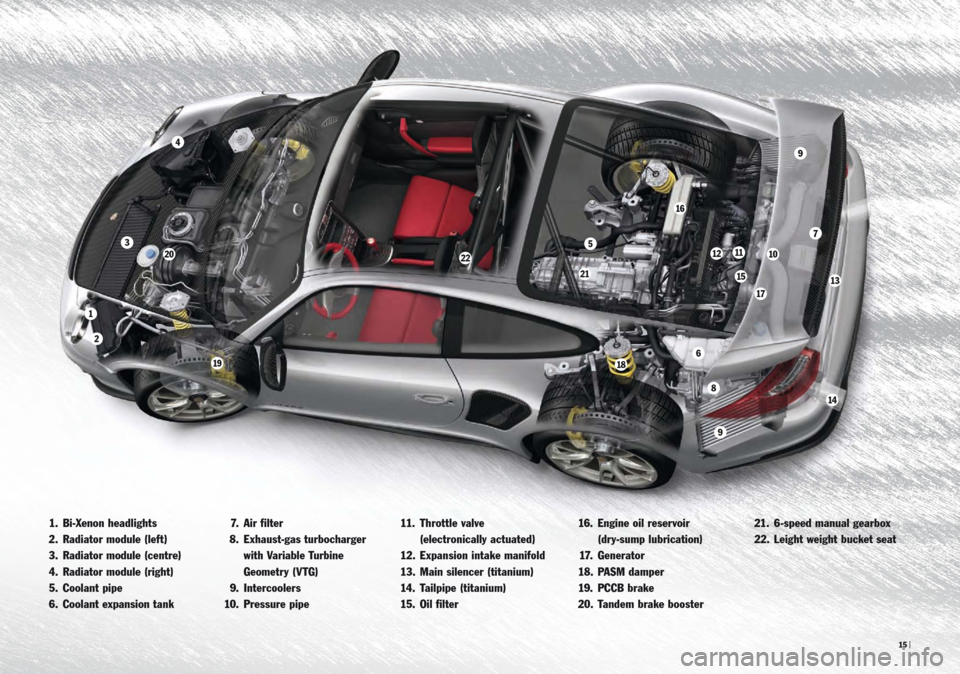
2
1
3
4
5
6
7
8
9
9
101112
13
14
15
16
17
1819
20
21
22
15 |
1. Bi-Xenon headlights
2. Radiator module (left)
3. Radiator module (centre)
4. Radiator module (right)
5. Coolant pipe
6. Coolant expansion tank 7. Air filter
8. Exhaust-gas turbocharger
with Variable Turbine
Geometry (VTG)
9. Intercoolers
10. Pressure pipe 11. Throttle valve
(electronically actuated)
12. Expansion intake manifold
13. Main silencer (titanium)
14. Tailpipe (titanium)
15. Oil filter 16. Engine oil reservoir
(dry-sump lubrication)
17. Generator
18. PASM damper
19. PCCB brake
20. Tandem brake booster 21. 6-speed manual gearbox
22. Leight weight bucket seat
Page 13 of 35
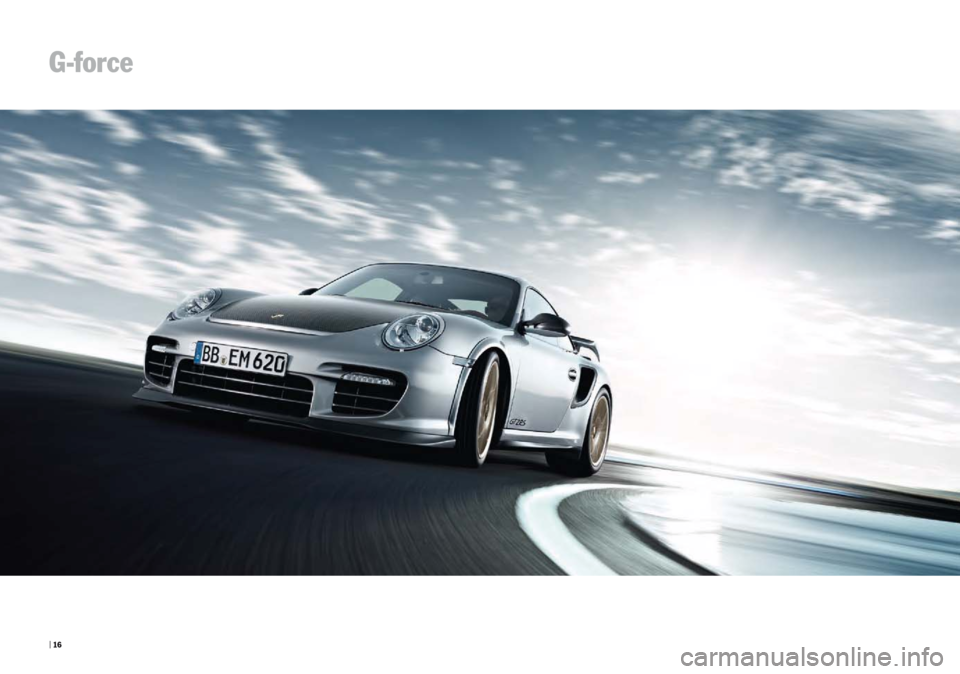
| 16
G-force
Page 14 of 35
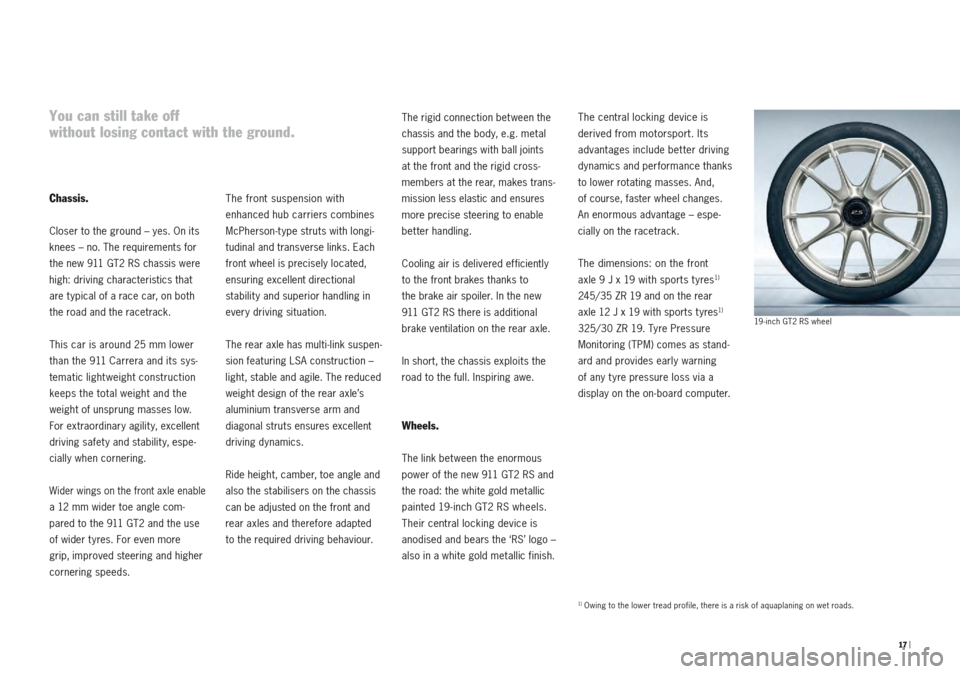
17 |
Chassis.
Closer to the ground – yes. On its
knees – no. The requirements for
the new 911 GT2 RS chassis were
high: driving characteristics that
are typical of a race car, on both
the road and the racetrack.
This car is around 25 mm lower
than the 911 Carrera and its sys-
tematic lightweight construction
keeps the total weight and the
weight of unsprung masses low.
For extraordinary agility, excellent
driving safety and stability, espe-
cially when cornering.
Wider wings on the front axle enable
a 12 mm wider toe angle com-
pared to the 911 GT2 and the use
of wider tyres. For even more
grip, improved steering and higher
cornering speeds.
The front suspension with
enhanced hub carriers combines
McPherson-type struts with longi-
tudinal and transverse links. Each
front wheel is precisely located,
ensuring excellent directional
stability and superior handling in
every driving situation.
The rear axle has multi-link suspen-
sion featuring LSA construction –
light, stable and agile. The reduced
weight design of the rear axle’s
aluminium transverse arm and
diagonal struts ensures excellent
driving dynamics.
Ride height, camber, toe angle and
also the stabilisers on the chassis
can be adjusted on the front and
rear axles and therefore adapted
to the required driving behaviour. The rigid connection bet ween the
chassis and the body, e.g. metal
support bearings with ball joints
at the front and the rigid cross-
members at the rear, makes trans-
mission less elastic and ensures
more precise steering to enable
better handling.
Cooling air is delivered efficiently
to the front brakes thanks to
the brake air spoiler. In the new
911 GT2 RS there is additional
brake ventilation on the rear axle.
In short, the chassis exploits the
road to the full. Inspiring awe.
Wheels.
The link between the enormous
power of the new 911 GT2 RS and
the road: the white gold metallic
painted 19-inch GT2 RS wheels.
Their central locking device is
anodised and bears the ‘RS’ logo –
also in a white gold metallic finish.
The central locking device is
derived from motorsport. Its
advantages include bet ter driving
dynamics and performance thanks
to lower rotating masses. And,
of course, faster wheel changes.
An enormous advantage – espe-
cially on the racetrack.
The dimensions: on the front
axle 9 J x 19 with sports tyres
1)
245/35 ZR 19 and on the rear
axle 12 J x 19 with sports tyres
1)
325/30 ZR 19. Tyre Pressure
Monitoring (TPM) comes as stand-
ard and provides early warning
of any tyre pressure loss via a
display on the on-board computer.
You can still take off
without losing contact with the ground.
19 -inch GT2 RS wheel
1) Owing to the lower tread profile, there is a risk of aquaplaning on wet roads.
Page 15 of 35
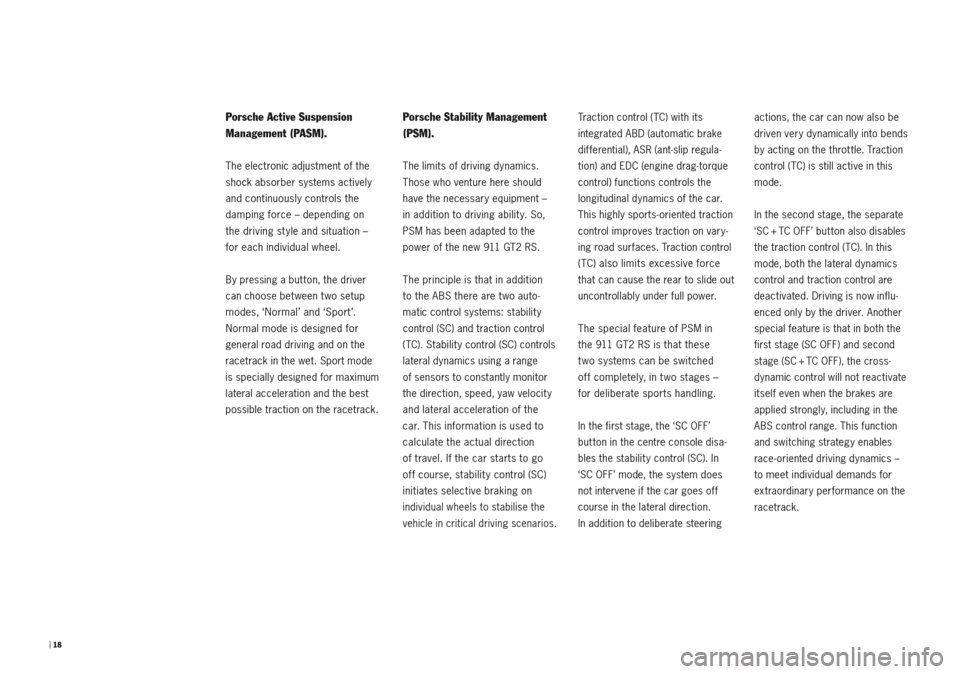
| 18
Porsche Active Suspension
Management (PASM).
The electronic adjustment of the
shock absorber systems actively
and continuously controls the
damping force – depending on
the driving style and situation –
for each individual wheel.
By pressing a button, the driver
can choose between two setup
modes, ‘Normal’ and ‘Sport ’.
Normal mode is designed for
general road driving and on the
racetrack in the wet. Sport mode
is specially designed for maximum
lateral acceleration and the best
possible traction on the racetrack.
Porsche Stability Management
(PSM).
The limits of driving dynamics.
Those who venture here should
have the necessary equipment –
in addition to driving ability. So,
PSM has been adapted to the
power of the new 911 GT2 RS.
The principle is that in addition
to the ABS there are
two auto-
matic control systems: stability
control (SC) and traction control
(TC). Stability control (SC) controls
lateral dynamics using a range
of sensors to constantly monitor
the direction, speed, yaw velocity
and lateral acceleration of the
car. This information is used to
calculate the actual direction
of travel. If the car starts to go
off course, stability control (SC)
initiates selective braking on
individual wheels to stabilise the
vehicle in critical driving scenarios.
Traction control (TC) with its
integrated ABD (automatic brake
differential), ASR (ant-slip regula-
tion) and EDC (engine drag-torque
control) functions controls the
l ongitudinal dynamics of the car.
This highly sports-oriented traction
control improves traction on vary-
ing road surfaces. Traction control
(TC) also limits excessive force
that can cause the rear to slide out
uncontrollably under full power.
The special feature of PSM in
the 911 GT2 RS is that these
two systems can be switched
of f completely, in t wo stages –
for deliberate sports handling.
In the first stage, the ‘SC OFF’
button in the centre console disa-
bles the stability control (SC). In
‘SC OFF’ mode, the system does
not intervene if the car goes off
course in the lateral direction.
In addition to deliberate steering actions, the car can now also be
driven very dynamically into bends
by acting on the throttle. Traction
control (TC) is still active in this
mode.
In the second stage, the separate
‘SC + TC OFF’ button also disables
the traction control (TC). In this
mode, both the lateral dynamics
control and traction control are
deactivated. Driving is now influ-
enced only by the driver. Another
special feature is that in both the
first stage (SC OFF) and second
stage (SC + TC OFF), the cross-
dynamic control will not reactivate
itself even when the brakes are
applied strongly, including in the
ABS control range. This function
and switching strategy enables
race-oriented driving dynamics –
to meet individual demands for
extraordinary performance on the
racetrack.
Page 16 of 35
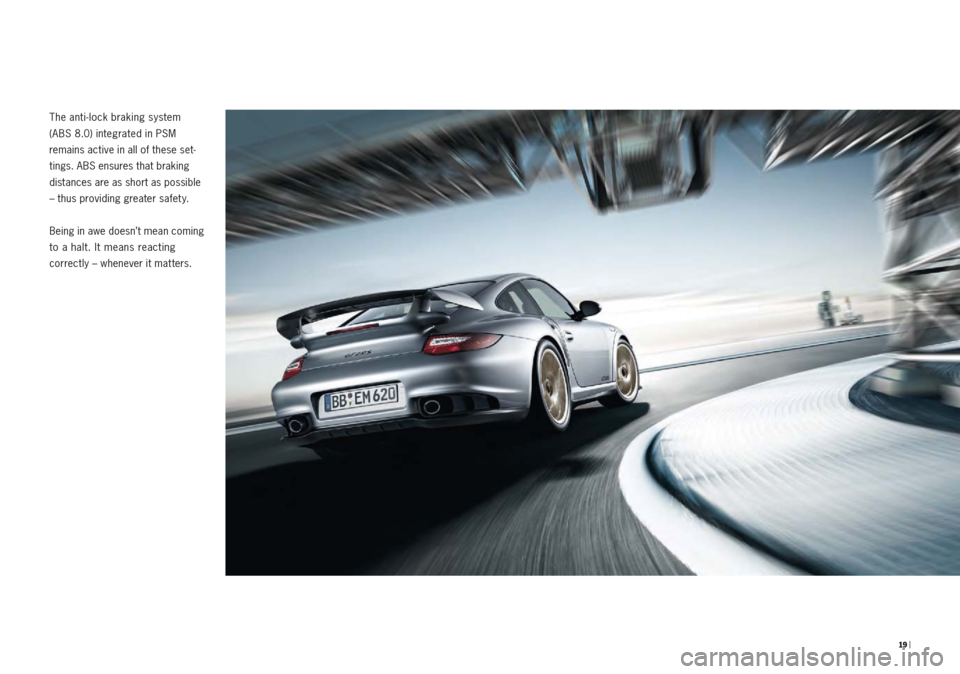
19 |
The anti-lock braking system
(ABS 8.0) integrated in PSM
remains active in all of these set-
tings. ABS ensures that braking
distances are as short as possible
– thus providing greater safety.
Being in awe doesn’t mean coming
to a halt. It means reacting
correctly – whenever it matters.
Page 17 of 35
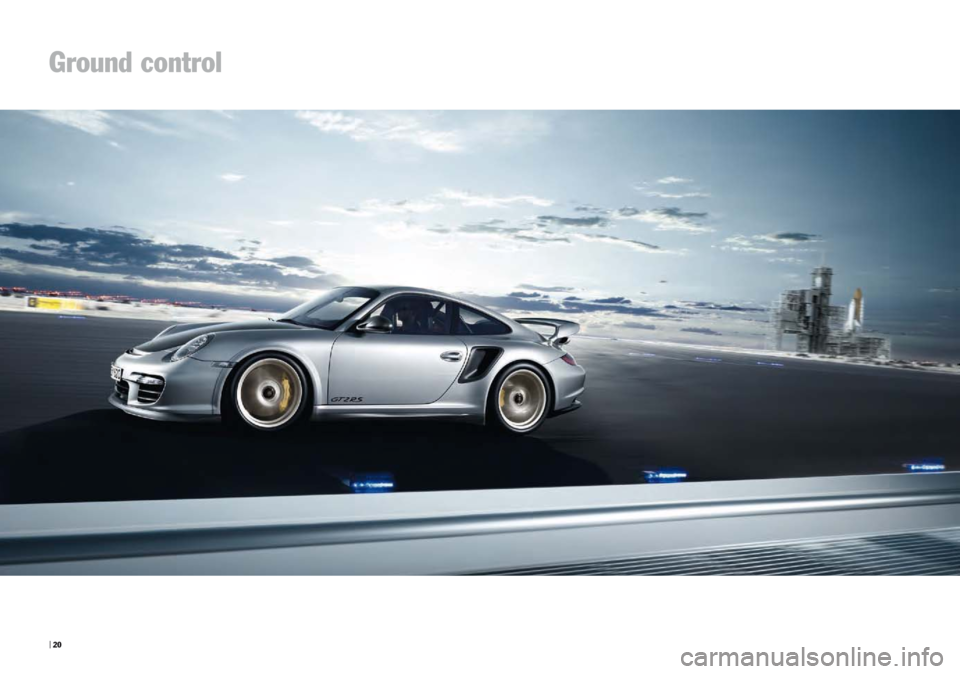
| 20
Ground control
Page 18 of 35
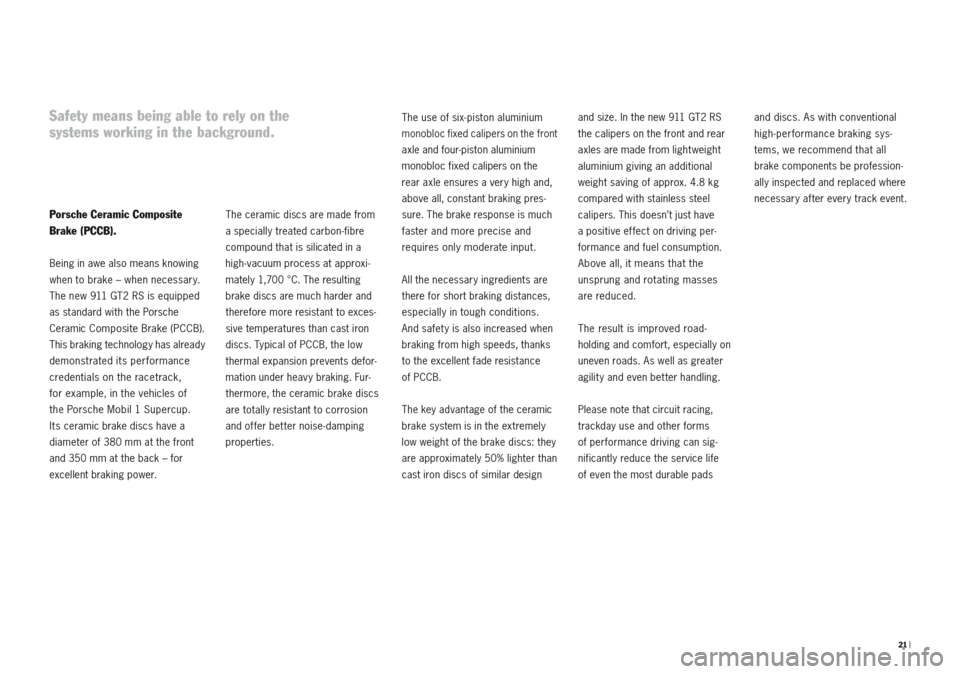
21 |
Porsche Ceramic Composite
Brake (PCCB).
Being in awe also means knowing
when
to brake – when necessary.
The new 911 GT2 RS is equipped
as
standard with the Porsche
Ceramic
Composite Brake (PCCB).
This braking technology has already
demonstrated its performance
credentials on the racetrack,
for example, in the vehicles of
the Porsche Mobil 1 Supercup.
Its
ceramic brake discs have a
diameter of 380 mm at the front
and 350 mm at the back – for
excellent braking power. The ceramic discs are made from
a specially treated carbon-fibre
compound that is silicated in a
high-vacuum process at approxi-
mately 1,700 °C. The resulting
brake discs are much harder and
therefore more resistant to exces-
sive temperatures than cast iron
discs. Typical of PCCB, the low
thermal expansion prevents defor-
mation under heavy braking. Fur-
thermore, the ceramic brake discs
are totally resistant to corrosion
and offer bet ter noise-damping
properties.The use of six-piston aluminium
monobloc fixed calipers on the front
axle and four-piston aluminium
monobloc fixed calipers on the
rear axle ensures a very high and,
above all, constant braking pres-
sure. The brake response is much
faster and more precise and
requires only moderate input.
All the necessary ingredients are
there for short braking distances,
especially in tough conditions.
And safety is also increased when
braking from high speeds, thanks
to the excellent fade resistance
of PCCB.
The key advantage of the ceramic
brake system is in the extremely
low weight of the brake discs: they
are approximately 50% lighter than
cast iron discs of similar design and size. In the new 911 GT2 RS
the calipers on the front and rear
axles are made from light weight
aluminium giving an additional
weight saving of approx. 4.8 kg
compared with stainless steel
calipers. This doesn’t just have
a positive effect on driving per-
formance and fuel consumption.
Above all, it means that the
unsprung and rotating masses
are reduced.
The result is improved road-
holding and comfort, especially on
uneven roads. As well as greater
agilit y and even bet ter handling.
Please note that circuit racing,
trackday use and other forms
of performance driving can sig-
nificantly reduce the service life
of even the most durable pads
and discs. As with conventional
high-performance braking sys-
tems, we recommend that all
brake components be profession-
ally inspected and replaced where
necessary after every track event.
Safety means being able to rely on the
systems working in the background.
Page 19 of 35
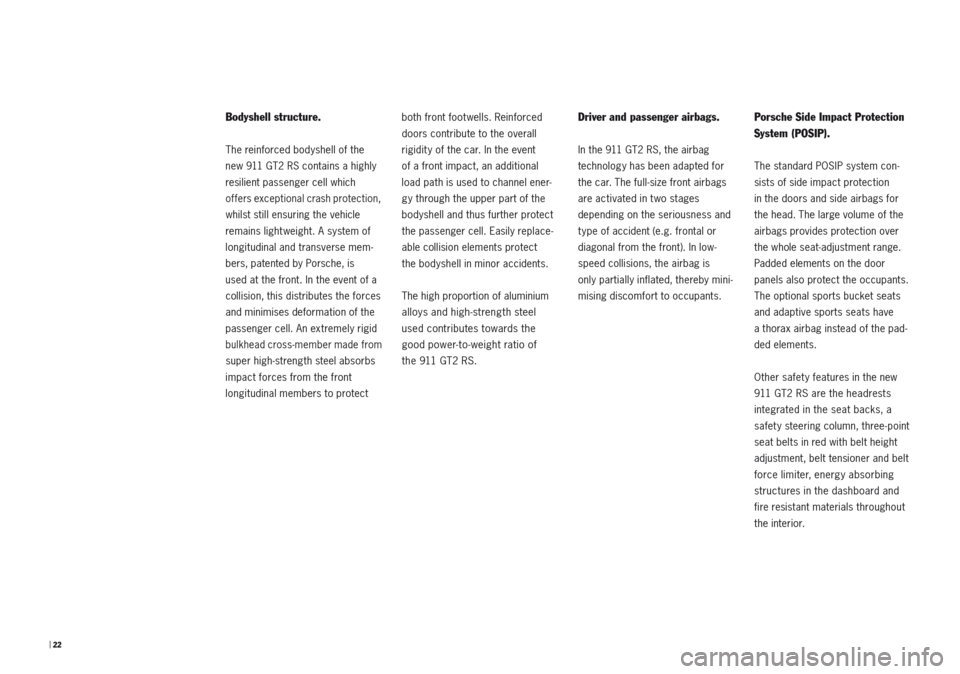
| 22
Bodyshell structure.
The reinforced bodyshell of the
new 911 GT2 RS contains a highly
resilient passenger cell which
offers exceptional crash protection,
whilst still ensuring the vehicle
remains lightweight. A system of
longitudinal and transverse mem-
bers, patented by Porsche, is
used at the front. In the event of a
collision, this distributes the forces
and minimises deformation of the
passenger cell. An extremely rigid
bulkhead cross-member made from
super high-strength steel absorbs
impact forces from the front
longitudinal members to protect both front footwells. Reinforced
doors contribute to the overall
rigidity of the car. In the event
of a front impact, an additional
load path is used to channel ener-
gy through the upper part of the
bodyshell and thus further protect
the passenger cell. Easily replace-
able collision elements protect
the bodyshell in minor accidents.
The high proportion of aluminium
alloys and high-strength steel
used contributes towards the
good power-to-weight ratio of
the 911 GT2 RS.
Driver and passenger airbags.
In the 911 GT2 RS, the airbag
technology has been adapted for
the car. The full-size front airbags
are activated in t wo stages
depending on the seriousness and
type of accident (e.g. frontal or
diagonal from the front). In low-
speed collisions, the airbag is
only partially inflated, thereby mini-
mising discomfort to occupants.
Porsche Side Impact Protection
System (POSIP).
The standard POSIP system con-
sists of side impact protection
in the doors and side airbags for
the head. The large volume of the
airbags provides protection over
the whole seat-adjustment range.
Padded elements on the door
panels also protect the occupants.
The optional sports bucket seats
and adaptive sports seats have
a thorax airbag instead of the pad-
ded elements.
Other safet y features in the new
911 GT2 RS are the headrests
integrated in the seat backs, a
safety steering column, three-point
seat belts in red with belt height
adjustment, belt tensioner and belt
force limiter, energy absorbing
structures in the dashboard and
fire resistant materials throughout
the interior.
Page 20 of 35
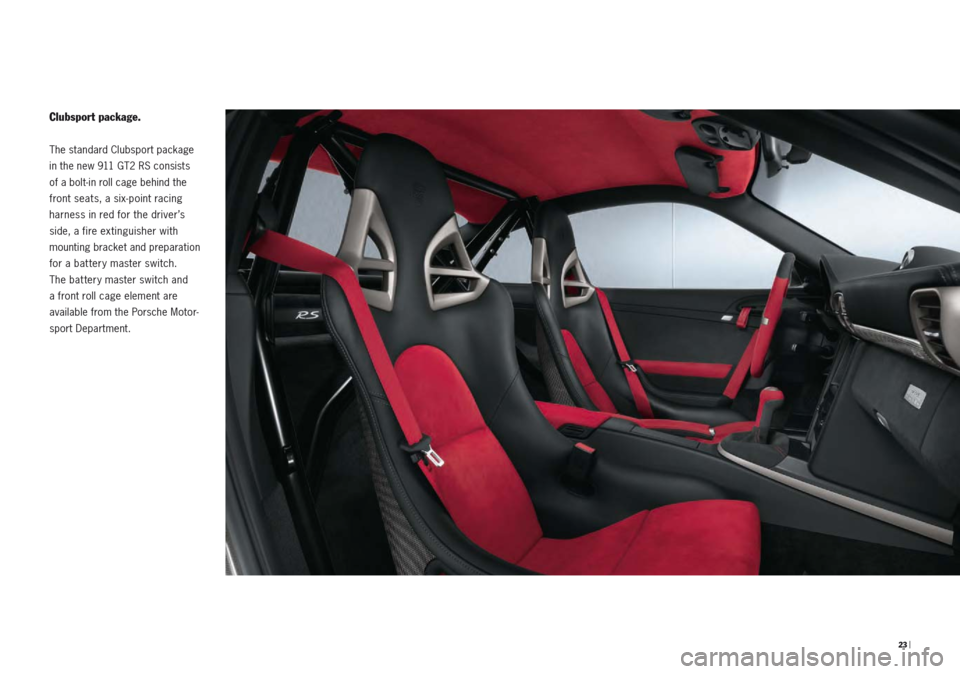
23 |
Clubsport package.
The standard Clubsport package
in the new 911 GT2 RS consists
of a bolt-in roll cage behind the
front seats, a six-point racing
harness in red for the driver’s
side, a fire extinguisher with
mounting bracket and preparation
for a battery master switch.
The battery master switch and
a front roll cage element are
available from the Porsche Motor-
sport Department.